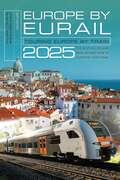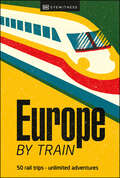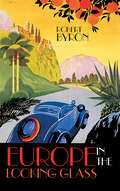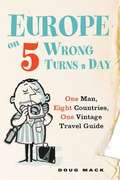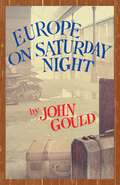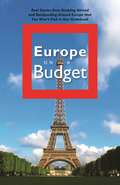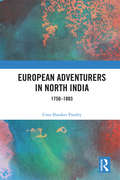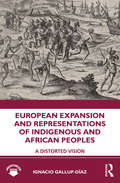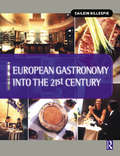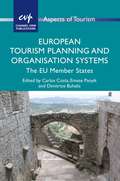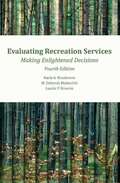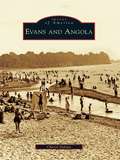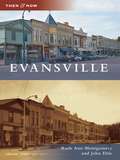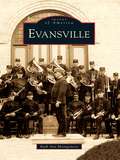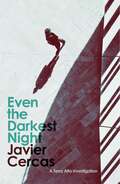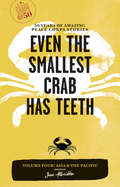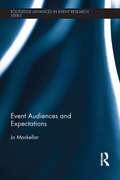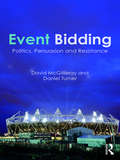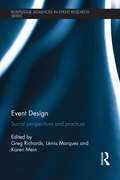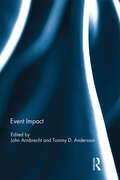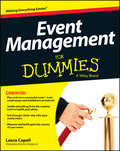- Table View
- List View
Europe by Eurail 2025: Touring Europe by Train
by LaVerne Ferguson-KosinskiEurope by Eurail has been the train traveler&’s one-stop source for visiting Europe&’s cities and countries by rail for nearly fifty years. Newly revised and updated, this comprehensive annual guide provides the latest information on fares, schedules, and pass options, as well as detailed information on more than one hundred specific rail excursions and sightseeing options.
Europe by Train
by DK EyewitnessTake to the rails and have a European adventure with this inspiring and practical guidebook.Thanks to Europe&’s ever-expanding and improving rail network, there&’s never been a better time to explore this diverse continent by train. But with so much ground to cover, it can be difficult to know where to start – and that&’s where Europe by Train comes in. Compiled by a team of travel experts, our 50 hand-picked itineraries will kickstart your plans, showing you how to join the dots between Europe&’s must-see destinations and introducing you to plenty of lesser-visited stops along the way. Featuring a mix of short trips and epic adventures, cross-continent and region-specific itineraries, this book provides endless inspiration, whether you&’re looking to hop between Europe&’s capitals, explore Scandinavia or experience the best of Italy.Packed inside Europe by Train you will find:- 50 inspiring and practical itineraries for exploring Europe by train.- Routes cover a variety of distances, from four-day trips to month-long adventures. - Each route covers either an epic cross-continent journey (eg from the North to the South, East to West) or a particular area, region or country (eg Beneluxe, Northern Italy, Finland), with the text describing the places you stop at rather than the journey between them.- Practical information details how to get between each stop, total distance travelled, trip duration and ticketing tips.- Some routes feature suggested detours and opportunities to extend your trip.Once your head is well and truly packed with rail trip ideas, you&’ll be ready to start planning out the details. This handy guidebook has all the route infographics, network maps and practical information – including advice on what tickets to buy, how to catch connections and tips for travelling on night trains – you need to get started. We&’ve also included detours and opportunities to extend the route, so you can curate your own rail adventure.
Europe from a Backpack
by Mark Pearson Martin WestermanIf you've ever wanted to backpack in Europe... If you want to relive your adventures... If you love good travel writing... Better than guidebooks, these first-person accounts paint vivid pictures of a traveler's experience in Europe. Like familiar music and favorite scents, they'll awaken a taste for adventure in those who have yet to travel, and bring back memories for those who have. Romance, surprise, discovery and wisdom all bubble through these authors' inviting pieces. At last, a collection of first-person eye-witness adventures that will keep you laughing, wondering, and walking with the well-traveled story tellers who take you inside Europe's must-see places. Billy Anderson stares down death at the running of the bulls in Pamplona. Lisa Cordeiro takes a "will work for food" approach to travel as a waitress at a Paris restaurant. And Mike Riley's desperate search for underwear in a Portuguese market... well, that's another story.
Europe in the Looking Glass
by Robert ByronThree rich young Englishmen cross pre-World War II Europe in an old car with a mixture of laugh-out-loud humor and perceptive commentary on art and architecture Turning a corner we suddenly found ourselves sliding down a precipice, tilted so far forward that it was necessary to hold ourselves back with our hands pressed against the dashboard, as half a dozen Apennine valleys beckoned invitingly below. Here [St Peter' s] Popes with black faces and golden crowns are wallowing twice life-size in the titanic folds of marble tablecloths, their ormolu fringes festooning upon the arms of graceful skeletons to disclose some Alice-in-Wonderland door or the grim hinges of some sepulchral grill . . . Best known as the author of The Road to Oxiana, published in 1937, Robert Byron had developed his considerable writing skills on this travel book which has not been in print since 1926. It describes a journey Byron made with three friends, driving across Europe between two world wars, and mixes political and historical analysis with architectural insights, classical scholarship, and the day-to-day adventures of three young and not very experienced travelers. For fans of Robert Byron' s work this will be a discovery; for others it will be an introduction. Includes nine original sketches made by the author during his travels.
Europe on 5 Wrong Turns a Day: One Man, Eight Countries, One Vintage Travel Guide
by Doug MackPrepare to Get Lost on the Beaten Path. . . When Doug Mack picked up a 1963 edition of Europe on Five Dollars a Day, he stumbled on an inspired idea: to boldly go where millions have gone before, relying only on the advice of a travel guide that's nearly a half century out-of-date. Add to the mix his mother's much- documented grand tour through Europe in the late 1960s, and the result is a funny and fascinating journey into a new (old) world, and a disarming look at the ways the classic tourist experience has changed- and has not-in the last generation. After a whirlwind adventure spanning eight countries-and costing way more than five dollars a day-Mack's endearing account is part time travel, part paean to Arthur Frommer's much-loved guide, and a celebration of the modern traveler's grand (and not-so-grand) tour. .
Europe on Saturday Night
by John Gould"We left our Maine and our United States at home and we journeyed amongst other peoples with courtesy to them and credit to ourselves."That is John Gould's definition of good travelers; and he and his wife are charming examples of this as they tour through Germany, Denmark, Austria, Italy, France, England, and Scotland. You'll discover what a delight it is to travel Gould family style, for that is Maine style with the extra sparkle of Gould's wry Down East humor. It's a friendly book, but Gould lets no country, group, individual, or menu get away with pomposity or an unearned reputation. There is much to discover, both good and bad as the Goulds search for the quality of European life and bring readers into the presence of ordinary, and fascinating, Europeans.
Europe on a Budget
by Mark Pearson Martin WestermanThis collection of 42 first-person accounts about backpacking in Europe will awaken a taste for adventure in those who have yet to travel, and bring back memories for those who have. Romance, surprise, discovery and wisdom all bubble through these authors' riveting pieces.- Find a surprise romance in the fresh sea air of Cinque Terre- Dance the flamenco in Granada or sleep beneath the stars on a Barcelona beach- Sneak past Vatican guards to see Michaelangelo's Pieta- Lose your wallet, your passport, your entire pack-or maybe just your old ways of thinkingIf you've ever wanted to backpack or study abroad in Europe...If you want to relive your adventures...If you love good travel writing...Then sit back and enjoy Europe on a Budget - and feel your love for travel come alive in this one-of-a-kind collection of unique travel tales.
European Adventurers in North India: 1750–1803
by Uma Shanker PandeyThis book explores how European, particularly French, adventurers shaped early modern India. It highlights the significant contributions of these adventurers in social, political, economic, and intellectual life of north India in the 18th and the 19th centuries. The author examines how the French adventurers played a key role in bringing Western science and ideas to a polity in flux. He examines the role of individuals like René Madec, Sombre, De Boigne, Perron, Gentil, Canaple, Delamarr, Sonson, and Pedrose, who made instrumental contributions in modernising armies of pre-modern states in South Asia. The volume also underlines how French adventurers’ commercial networks developing from their enterprises opened up markets in the heartlands of north India for European consumers. Further, it brings to the fore intellectual pursuits of the leading French figures such as Anquetil Duperron, Polier, Gentil, De Boigne, and Perron, whose engagement with Indian literature opened a new chapter framing studies of the Occident. Rich in French, English, and translated Persian archival resources, this book will be of interest to scholars and researchers of colonial history, early modern history, military history, and South Asian studies.
European Expansion and Representations of Indigenous and African Peoples: A Distorted Vision
by Ignacio Gallup-DíazThis book presents a bold, multifaceted interpretation of early English imperial actions by examining the ways in which English empire-builders and travelers interacted with Indigenous and African peoples during the long process of colonization in the Americas. Ignacio Gallup-Díaz argues that early English imperial actors were primarily motivated by practical concerns rather than abstract ideologies—from reacting to, learning from, and avoiding the ongoing Spanish and Portuguese imperial projects to the dynamic collision of English imaginings of empire with the practical realities of governing non-European peoples. The text includes an appendix of primary sources that allows students and instructors to engage with English imperial thinking directly. Readers are encouraged to critically examine English accounts of this period in an attempt to see the Indigenous and African peoples who are embedded in them. European Expansion and Representations of Indigenous and African Peoples provides an invaluable new framework for undergraduate students and instructors of early American history, Atlantic history, and the history of race and imperialism more broadly.
European Gastronomy into the 21st Century
by John Cousins Cailein GillespieGastronomy is the art and science of good eating and drinking: a concept that extends outwards to embrace wider notions of tradition, culture, society and civilisation. This book provides a rigorous, well researched and much needed treatment of the subject, systematically outlining: * the development of European gastronomic tradition, and the social, economic, philosophical and geographical contexts of change* the experiences, philosophies and relative contributions of great gastronomes, past and present* the interplay of traditional and contemporary influences on modern gastronomy* the relationship between gastronomy and and travel and tourism* salient issues of nutrition, food hygiene and health promotionTaking an all-encompassing look at the subject of gastronomy past, present and future, 'European Gastronomy into the 21st Century' uses example menus and case studies to demonstrate the theory. It also provides an insight into the business arena, using key destination restaurants to illustrate management techniques and marketing issues. Accessible and highly structured, the book guides the reader through its wide-ranging and thought-provoking content.
European Tourism Planning and Organisation Systems
by Carlos Costa Emese PanyikThis book provides a systematic, country-by-country analysis of tourism policy, planning and organisation in the EU. Its main objective is to explore 21st century policy responses to the global challenges shaping tourism planning and organisation systems in the EU. The book offers a new critical approach to comparative policy analysis of EU member states and focuses on six key themes: territory, actors and structures, economics, policy, methods and techniques and vision. The book is designed primarily for undergraduate and postgraduate tourism students and researchers. The book will also be useful for industry practitioners who would like to engage in the theoretical principles and the conceptualisation of planning and organisation systems.
Europe’s India: Words, People, Empires, 1500 - 1800
by Sanjay SubrahmanyamWhen Portuguese explorers first arrived in India, the maritime passage initiated an exchange of goods as well as ideas. European ambassadors, missionaries, soldiers, and scholars who followed produced a body of knowledge that shaped European thought about India. Sanjay Subrahmanyam tracks these changing ideas over the entire early modern period.
Evaluating Recreation Services: Making Enlightened Decisions
by Karla A. Henderson M. Deborah Bialeschki Laurie P. BrowneEvaluation is a process that each of us uses every day. Professionals in any field of human services must have the means to access and assess information. Having information is not enough, however, unless that information can be applied and used. To organize and manage recreation services (i.e., all elements related to the various specialties in the field such as parks, tourism, sports, arts, therapeutic recreation, camping, event management), information is needed about people's preferences, needs, and behaviors and the programs, administrative structures, and resources that comprise the organizations. To build a body of knowledge and to document the value of recreation, systematic processes are necessary. Evaluation and research can provide information that will enable ""enlightened decisions."" Evaluating Recreation Services: Making Enlightened Decisions, Fourth Edition, is about systematic evaluation and research that focuses specifically on identifying explicit evaluation criteria or research questions, collecting evidence or data, and making judgments about the value or the worth of something applied to service improvement or knowledge development. This book aims to provide a basic overview and working knowledge of procedures. Knowing basic steps in evaluation research and having some familiarity with evaluation and research tools can help you to begin a process of lifelong learning about systematic inquiry.
Evans and Angola
by Cheryl DelanoIncorporated in 1821, the area that is now the town of Evans saw its first permanent settlers just prior to the War of 1812. The village of Angola developed later with the establishment of the railroad, which also brought industry, most notably the internationally known Emblem Bicycle Company. Lake Erie also drew visitors and residents to the area. The miles of shoreline were home to summer camps for adults, as well as children, and the wealthiest families in the city of Buffalo built their summer homes there. Prominent among these estates was Graycliff, the summer home of Darwin Martin, designed by Frank Lloyd Wright. William H. Carrier, known as the "Father of Air-Conditioning" and the town's most famous resident, was born and educated in Evans and graduated from Angola High School in 1894.
Evansville
by John Ehle Ruth Ann MontgomeryEvansville, settled in 1839, developed as an important agricultural trade center. Log cabins, farms, and small industries were built, and the population grew from less than 10 families in the beginning to nearly 5,000 people in 2009. Then and Now: Evansville is a unique look at how the community has changed from the 1900s to today. Ruth Ann Montgomery, author of Images of America: Evansville for Arcadia Publishing, is Evansville's historian. John Ehle, an Evansville resident for many years, has conducted interviews with local veterans and those who lived through the Great Depression.
Evansville (Images of America)
by Ruth Ann MontgomeryThe Evansville area was settled in 1839 and the village platted in 1855 on the hopes that the railroad would come through. It was named for Evansville's first physician, Dr. John M. Evans. When the railroad arrived in 1863, Evansville's prosperity was assured. There were many opportunities for growth in agriculture, manufacturing, and commerce. The Chicago and Northwestern Railroad offered passenger and freight service to major markets in Chicago and the West. Local farmers found national and international markets for their prizewinning livestock and produce. The Evansville Seminary and a strong public school system provided educational opportunities. Literary societies, churches, and veterans groups provided social activities. Talented 19th- and 20th-century architects and craftsmen were responsible for the fine collection of architectural styles in Evansville.
Evansville: The World War Ii Years (Images of America)
by Darrel BighamAs we approach a new century and a new millennium, we should consider how people in American communities dreamed about and participated in the coming of the twentieth century 100 years ago. The focus of this work is Evansville--100 years ago the only emerging metropolis between Louisville and St. Louis, and then, as now, the radial center of a hinterland stretching in all directions from 75 to 125 miles. The book illustrates how the city landscape changed because of the early industrial era, how people made a living, how people related toeach other, and how they spent their leisure time. About one-fifth of the images in this collection focus on the residents of the Evansville region; the Tri-State of southwestern Indiana, western Kentucky, and southern Illinois, which has been Evansville'sservice area since the 1850s.
Even Darkness Sings: From Auschwitz To Hiroshima: Finding Hope And Optimism In The Saddest Places On Earth
by Thomas H. CookA memoir of a lifetime's adventure to some of the darkest places on earth—and the first work of nonfiction from this award-winning crime novelist. Thomas Cook has always been drawn to dark places, for the powerful emotions they evoke and for what we can learn from them. These lessons are often unexpected and sometimes profoundly intimate, but they are never straightforward. With his wife and daughter, Cook travels across the globe in search of darkness—from Lourdes to Ghana, from San Francisco to Verdun, from the monumental, mechanised horror of Auschwitz to the intimate personal grief of a shrine to dead infants in Kamukura, Japan. Along the way he reflects on what these sites may teach us, not only about human history, but about our own personal histories. During the course of a lifetime of traveling to some of earth's most tragic locals, from the leper colony on Molokai to ground zero at Hiroshima, he finds not only darkness, but a light that can illuminate the darkness within each of us. Written in vivid prose, this is at once a personal memoir of exploration (both external and internal) and a strangely heartening look at the radiance and optimism that may be found at the very heart of darkness.
Even the Darkest Night: A Terra Alta Investigation
by Javier CercasA Melchor Marín novel. Winner of Spain's biggest literary prize - the Premio PlanetaWhen Melchor goes to investigate the horrific double-murder of a rich printer and his wife in rural Cataluña nothing quite adds up. The young cop from the big city, hero of a foiled terrorist attack, has been sent to Terra Alta till things quieten down. Observant, streetwise and circumspect, Melchor is also an outsider.The son of a Barcelona prostitute who never knew his father, Melchor rapidly fell into trouble and was jailed at 19, convicted of driving for a Colombian drug cartel. While he was behind bars, he read Hugo's Les Misérables, and then his mother was murdered. Admiring of both Jean Valjean and Javert - but mostly the relentless Javert - he decided to become a policeman.Now he is out for revenge, but he can wait, and meanwhile he has discovered happiness with his wife, the local librarian, and their daughter, who is, of course, called Cossette.Slowly at first, and then more rapidly once ordered to abandon the case, he tracks the clues that will reveal the larger truth behind what appears at first to be a cold-blooded, professional killing.Translated from the Spanish by Anne McLean
Even the Smallest Crab Has Teeth: 50 Years of Amazing Peace Corps Stories
by Jane AlbrittonFrom land-locked Afghanistan to the smallest of islands in the far reaches of the Pacific Ocean, stories by peace Corps Volunteers from this region come from (mostly) Hindu India-1,269,210 square miles worth of democracy patched together from princely states-Confucian Korea, Muslim Indonesia and Buddhist Thailand.Imagine delivering a baby-with the help of the handy Peace Corps first aid kit-on a rust bucket of a passenger ship in the Pacific or practicing agriculture with armed Pathan farmers in the Pashtun region of Pakistan. How about trekking into the far reaches of Afghanistan to inoculate women and children for small pox, or returning 25 years later to your school in India to find that, yes, your students do remember you? These stories say. "I Was There."
Event Audiences and Expectations: Event Audiences And Expectations (Routledge Advances in Event Research Series)
by Jo MackellarEvent Audiences and Expectations for the first time examines why people participate in festivals and events, the types of events which stimulate participation, and the fanatical antics of fans who become involved in these events. By doing so the book offers significant insight into how event managers can entice and manage participant expectations as well as manage audience involvement. The book is based on primary research using participant observation, as well as in-depth interviews with event participants, event managers and government officials involved in over 50 international events to gain new perspectives into audience behaviour and participatory events. Using numerous international case studies and examples, the book offers a comprehensive outline of the reasons why people participate in festivals and events, the social world that reinforces their behaviours, and strategies that can be used to ensure future successful participatory events. This thought-provoking and original volume will be valuable reading for students, researchers, events managers and tourism and community planners at all levels of government.
Event Bidding: Politics, Persuasion and Resistance
by David McGillivray Daniel TurnerBidding contests for sporting and cultural events are attracting increasing media and public attention. Yet, despite the cost, size and scale of these bidding contests, relatively little academic attention has been paid to the strategies and tactics used to develop successful bids. Event Bidding: Politics, Persuasion and Resistance develops a comprehensive, critical understanding of the bidding processes surrounding the award of major peripatetic events. This is achieved by drawing together existing knowledge on the subject of event bidding, combining this with historical and contemporary examples to enable a critical commentary on the bidding process itself and the struggle for power that it represents. The text draws on case studies of ‘mega events’ including the FIFA World Cup and the Olympic Games as well as a range of smaller peripatetic events from across the world to analyse the bidding process and some of the increasingly controversial issues which emerge during often lengthy and expensive bid campaigns. Finally, the text reflects on a range of critical issues of contemporary significance in bidding contests, including the growing ethical and governance issues surrounding the development and award of events as well as the impact of growing oppositional movements surrounding each contest. This timely volume brings theory and practice together in one place to produce a critical appraisal of a phenomenon with a relatively recent history and is particularly suitable for students, researchers and academics of sports, events, tourism and related subject fields focusing on the strategic and political dimensions of major events.
Event Design: Social perspectives and practices (Routledge Advances in Event Research Series)
by Greg Richards Lénia Marques Karen MeinEvents are becoming more complex as their range of functions grows, as meeting places, creative spaces, economic catalysts, social drivers, community builders, image makers, business forums and network nodes. Effective design can produce more successful business models that can help to sustain cultural and sporting activities even in difficult economic times. This process requires creative imagination, and a design methodology or in other words ‘imagineering’. This book brings together a wide range of international experts in the fields of events, design and imagineering to examine the event design process. It explores the entire event experience from conception and production to consumption and co-creation. By doing so it offers insight into effective strategies for coping with the shift in value creation away from transactional economic value towards social and relational value which benefit a range of stakeholders from the community to policy makers. Mega-events, small community events, business events and festivals in eight different countries are examined providing an international view of social issues in event design.A wide selection of current research perspectives is employed, integrating both theoretical and applied contributions. The multidisciplinary nature of the material means that it will appeal to a broad academic audience, such as art and design, cultural studies, tourism, events studies, sociology and hospitality.
Event Impact
by John Armbrecht Tommy D. AnderssonEvents are increasingly used instrumentally to achieve goals of society such as cultural development, destination branding or economic development. Event impacts are, however, routinely measured from a purely economic perspective. Event Impact fills an important niche and a void in the literature on events by taking a holistic approach, incorporating issues like value creation, experiential value, value measurement, sustainability and impact assessment. It is one of the first books devoted to comprehensively dealing with the subject of event impacts, combining the ideas of an international group of academics to tackle an expanding area of research that cannot be met by the work of a single researcher. Methodological concepts such as triple impact assessment, cost–benefit analysis, travel cost method and Q-sort are combined, applied and tested in an event context, creating a unique book that broadens and deepens our knowledge about event impacts theoretically, methodologically as well as empirically. This book was originally published as a special issue of the Scandinavian Journal of Hospitality and Tourism.
Event Management For Dummies
by Laura CapellWhether you want to break into this burgeoning industry, or you simply need to plan an event and don't know where to start, there's something for all would-be event planners in Event Management For Dummies. Packed with tips, hints and checklists, it covers all aspects of planning and running an event - from budgeting, scheduling and promotion, to finding the location, sorting security, health and safety, and much more. Open the book and find: Planning, budgeting and strategy Guests and target audience Promoting and marketing events Location, venue and travel logistics Food, drink, entertainment and themes Security, health and safety, permissions, insurance and the like Tips for building a career in event management
